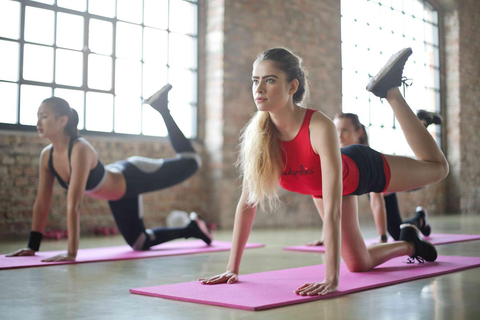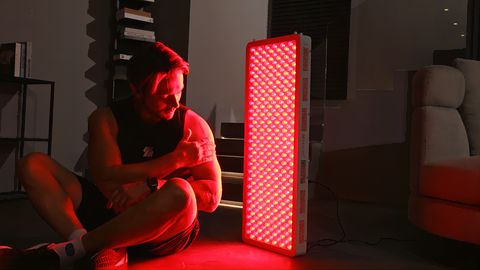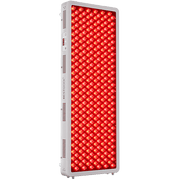Rest and recovery are essential components of any workout program. Recovery after exercise can have a significant impact on your fitness and performance, and it can also make your training more effective. Recovery after exercise is essential for muscle tissue repair and strength building, especially after high-intensity training, because muscles take around 24 to 48 hours to repair and rebuild. Retraining too soon after strenuous exercise only leads to tissue failure rather than building. Unfortunately, most people don't focus on a recovery plan after exercise. Today, we share the fastest way to recover after strenuous exercise with a red light therapy.

Science Behind Red Light Therapy
Red light therapy, or photobiomodulation, stands out in a world full of innovative therapies for its unique approach to rehabilitation and recovery. Low-level light therapy dates back thousands of years, with historical evidence. Ancient civilizations such as the Egyptians, Greeks, and Romans employed sunlight and other forms of light to treat various conditions. Red light therapy mainly works by acting on the mitochondria of the body's cells, which is also known as the powerhouse (ATP generator) of the cells. The science behind it is fascinating - these red and near-infrared lights in the ranges of 660-850 nm penetrate layers of skin to different depths, provide energy to cells, allow them to work more efficiently, and promote damage repair, cell growth, and other benefits.
How can you maximize the benefits of post-strenuous exercise with red light therapy?
Whether you're a professional athlete or a fitness warrior, incorporating red light therapy into your recovery routine can help you recover faster from high-intensity workouts and minimize the risk of injury. It's a safe and effective way to complement other recovery strategies, such as rest, proper nutrition, and stretching.
- Reduced Muscle Soreness
One of the widely accepted benefits of red light therapy is the ability to speed up muscle recovery. Engaging in strenuous physical activity subjects our muscles to microscopic tears and inflammation. RLT helps reduce inflammation by increasing blood flow to the affected area, facilitating the delivery of oxygen and nutrients needed for healing. RLT also stimulates the production of collagen, a protein that plays a critical role in tissue repair. It has been shown to improve increasing muscle strength and endurance. It reduces athletic acute muscle pain and helps combat delayed onset muscle soreness (pain that occurs 24 to 48 hours after exercise). Light energy stimulates mitochondria within cells, boosting energy production and improving overall muscle function.
- Injuries Prevention
Boosting performance, as well as minimizing the risk of potential injuries, is the ultimate goal of athletes. Studies have found that red light therapy has anti-inflammatory properties. By reducing muscle inflammation, athletes can recover faster from intense workouts and prevent injuries. Additionally, the therapy can help relieve muscle pain, allowing athletes to train more effectively. Collagen is essential for maintaining healthy connective tissue, and it plays a vital role in fixing muscle strains or tears. Red light therapy stimulates collagen production, promotes tissue repair, and reduces the risk of injury. By increasing blood circulation, reducing inflammation, and boosting collagen production, this treatment contributes to overall athletic health and longevity.

Red Light Therapy Equipment
Not all red light therapy devices offer similar benefits. The differences between various red light therapy equipment features directly impact the physical benefits. Understanding these factors will ensure safe and effective applications while maximizing the potential benefits of low-power laser treatment innovations.
Duration and frequency of treatment
In terms of the duration and frequency of use of home-based devices – gradually expose your body to RLT and give your body time to adjust it. Excessive use may result in diminishing effects. A typical session may last 10-20 minutes, depending on the device power output, but always refer to the manufacturer's instructions for best results, but don't overdo it.
Select Safe Device
If you're considering introducing this technology into your home, make sure you choose an FDA-cleared device with proper safety features, such as an automatic shut-off timer, that prevents the risk of overheating that comes with prolonged use.
Appropriate Wavelength and Device Type
Each type of wavelength has unique therapeutic benefits, according to numerous studies cited by the National Center for Biotechnology Information (NCBI). Select an LED that provides both near-infrared NIR and visible red light to maximize benefits.
Full Body Red Light Therapy for Comprehensive Recovery
RLT devices come in different types, from handheld units to full-body panels. You can choose according to your therapeutic outcomes. Whole-body RLT is usually recommended for post-strenuous exercise recovery and strength. A 2014 trial tested the effects of red light therapy on muscle recovery up to 4 days after "strenuous exercise" in healthy young adults. The RLT group showed significantly enhanced strength and reduced muscle soreness and injury risk.

Tips for Integrating Red Light Therapy into Post-Strenuous Exercise Regimens
Red light therapy can be added into post-strenuous exercise recovery regimens in the following ways:
Pre-workout
Use red light therapy before a workout to warm up muscles, increase blood flow, and improve oxygenation. This helps prevent injuries and improve performance.
Post-workout
After a strenuous workout, red light therapy can help muscles recover by reducing inflammation, relieving soreness, and speeding up the healing process. Spend 10-15 minutes targeting the areas of your body that need the most attention.
Injury recovery
If you're recovering from an injury, it can help speed up the healing process by promoting tissue repair and reducing pain and inflammation. Consult a healthcare professional for specific treatment options.
Consistency is key
It is important to maintain consistency in therapy to ensure benefits. Incorporate RLT into your daily routine a few times a week for the best outcomes.
Summary and Conclusion
- Red light therapy is scientifically based, safe, non-invasive, and versatile phototherapy.
- The power of specific wavelengths can heal your body like never before as it goes beyond the surface and also addresses inflammation in various parts of the body.
- Athletes strongly believe that it can improve athletic performance and speed up recovery after training. Incorporating RLT as a complementary therapy alongside existing post-exercise recovery methods could be beneficial for professional athletes and fitness enthusiasts.
References and Citations
[1] Glass G. E. (2021). Photobiomodulation: The Clinical Applications of Low-Level Light Therapy. Aesthetic surgery journal, 41(6), 723–738. https://doi.org/10.1093/asj/sjab025
[2] Dos Reeis, F. A., da Silva, B. A., Laraia, E. M., de Mello, R. M., Silva, P. H., Leal-Junior, E. C., & de Carvalho, (2014). Effects of pre or post exercise LLT (830 nm) therapy on skeletal muscle fatigue and biochemical markers of recovery in humans-double-blind placebo-controlled trial. Photomedicine and laser surgery, 32(2), 106–112. https://doi.org/10.1089/pho.2013.3617
[3] Peseriico, C. S., Zagatto, A. M., & Machado, F. A. (2019). Effects of Endurance Running Training Associated With Photobiomodulation-on 5Km Performance and Muscle Soreness: A Randomized Placebo-Controlled Trial. Frontiers in physiology, 10, 211. https://doi.org/10.3389/fphys.2019.00211
[4] Hsieh, C. C., Nosaka, K., Chou, T. Y., Hsu, S. T., & Chen, T. C. (2022). Effects of Far-Infrared Radiation-Lamp Therapy on Recovery From Simulated Soccer Match Running Activities in Elite Soccer Players. International journal of sports physiology performance, 17(9), 1432–1438. https://doi.org/10.1123/ijspp.2022-0084
[5] Tomazonni, S. S., Machado, C. D. S. M., De Marchi, T., Casaleechi, H. L., Bjordal, J. M., de Carvalho, P. T. C., & Leal-Junior, E. C. P. (2019). Infrared Low-Level Laser Therapy before Intense Progressive Running Test of High-Level Soccer Players-Effects on Functional, Muscle Damage, Inflammatory, and Oxidative Stress Markers;Randomized Controlled Trial. Oxidative medicine and cellular longevity, 2019, 6239058. https://doi.org/10.1155/2019/6239058














 Small
Small

 Moderate
Moderate

 Moderate
Moderate

 Moderate
Moderate

 Full
Full



